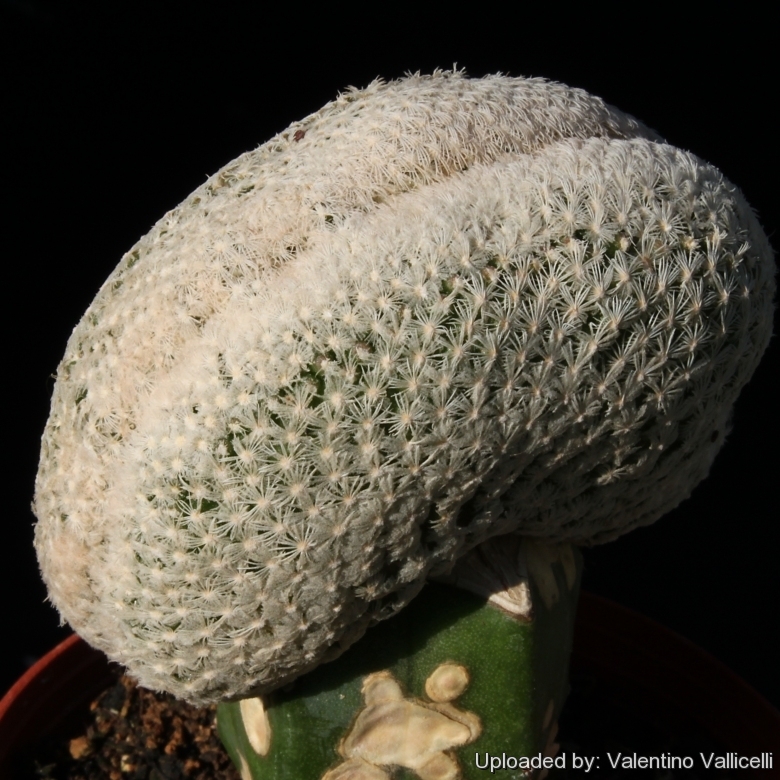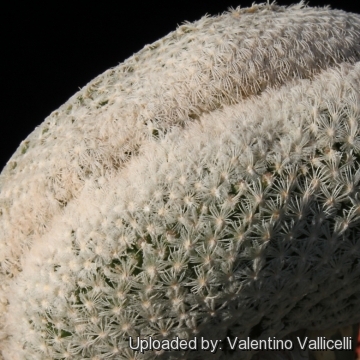= Mammillaria lasiacantha subs. egregia f. cristata
Accepted Scientific Name: Mammillaria lasiacantha subs. egregia
Mammillaria Postscripts 7: 3 (1998)

Mammillaria egregia f. cristata (Mammillaria lasiacantha subs. egregia f. cristata) Photo by: Valentino Vallicelli
Synonyms:
See all synonyms of Mammillaria lasiacantha
Description: Mammillaria lasiacantha subs. egregiaSN|17187]]SN|13772]] is a well known tiny geophytic cactus that forms small snow-white ball. The crest form (Mammillaria lasiacantha subs. egregia f. cristataSN|13772]]SN|17187]]) - despite to its beauty - is still very rare and sought after by collectors, for its unique features.
Habit: It is a small low growing crested cactus that will slowly forms white tangled groups up to 10 cm in diameter. The plant grows deep-seated in substrate and is inconspicuous, but it cultivation it is almost always seen grafted on columnar cacti.
Stem: Fan-shaped, grey-green, up to 5 cm in width (but usually less).
Tubercles: Cylindrical, without latex, axils bare.
Roots: Diffuse, not enlarged.
Spines: 50 or more per areole, in several series but all equally thin, mostly appressed, white, innocuous, bristle-like, 0,5-6 mm, glabrous, all interpreted as radial, innermost spines shortest.
Central: Absent.
Flowers: Approx 1 cm long and in diameter; dirty greenish-white or cream, usually with sharply defined midstripes of reddish-brown.
Blooming season (In Europe): January to March
Fruits: Scarlet, cylindrical or clavate, 10-25 mm long, with floral remnant persistent, ripening in June-August.
Seed: Black.
Subspecies, varieties, forms and cultivars of plants belonging to the Mammillaria lasiacantha group
 Mammillaria lasiacantha Engelm.: Single or forming Small clusters of 2 or 3 heads. Stems are spherical usually less than 5 cm in diameter. They usually have soft glabrous spines, but in some populations all plants may retain plumose spines at maturity.
Mammillaria lasiacantha Engelm.: Single or forming Small clusters of 2 or 3 heads. Stems are spherical usually less than 5 cm in diameter. They usually have soft glabrous spines, but in some populations all plants may retain plumose spines at maturity. Mammillaria lasiacantha var. denudata Engelm.: has always glabrous spines. For all other characteristics it is comparable to the standard Mammillaria lasiacantha. Distribution: Big Bend National Park (Brewster County), Texas.
Mammillaria lasiacantha var. denudata Engelm.: has always glabrous spines. For all other characteristics it is comparable to the standard Mammillaria lasiacantha. Distribution: Big Bend National Park (Brewster County), Texas. Mammillaria lasiacantha subs. egregia (Backeb. ex Rogoz. & Appenz.) D.R.Hunt: It forms small snow-white ball, usually unbranched, deep-seated in substrate and inconspicuous that become somewhat cylindrical with age up to 5 cm in diameter × 2-7 cm tall.
Mammillaria lasiacantha subs. egregia (Backeb. ex Rogoz. & Appenz.) D.R.Hunt: It forms small snow-white ball, usually unbranched, deep-seated in substrate and inconspicuous that become somewhat cylindrical with age up to 5 cm in diameter × 2-7 cm tall. Mammillaria lasiacantha subs. egregia f. cristata hort.: crested form. It will slowly forms white tangled groups up to 10 cm in diameter.
Mammillaria lasiacantha subs. egregia f. cristata hort.: crested form. It will slowly forms white tangled groups up to 10 cm in diameter.- Mammillaria lasiacantha subs. hyalina D.R.Hunt
 Mammillaria lasiacantha subs. magallanii (F.Schmoll ex R.T.Craig) D.R.Hunt: Small usually solitary slow growing species with short white spines. Stems globose to club shaped, green, up to 6 cm tall and 4.5 cm in diameter. Distribution: Coahuila and Durango.
Mammillaria lasiacantha subs. magallanii (F.Schmoll ex R.T.Craig) D.R.Hunt: Small usually solitary slow growing species with short white spines. Stems globose to club shaped, green, up to 6 cm tall and 4.5 cm in diameter. Distribution: Coahuila and Durango. Mammillaria lasiacantha f. wohlschlageri (Repp.) Hoeve: Small plants with a flat fuzzy stem and creamy flowers blooming abundantly in late winter-to early spring. Radial spiness 26-36, glassy white, brown tipped, 2 - 6 mm long.
Mammillaria lasiacantha f. wohlschlageri (Repp.) Hoeve: Small plants with a flat fuzzy stem and creamy flowers blooming abundantly in late winter-to early spring. Radial spiness 26-36, glassy white, brown tipped, 2 - 6 mm long. Mammillaria magallani var. hamatispina Backeb.: 50-70 creamy-yellowish radial spines with one hooked darker central spine.
Mammillaria magallani var. hamatispina Backeb.: 50-70 creamy-yellowish radial spines with one hooked darker central spine. Mammillaria neobertrandiana Backeb.: Nice pink spines, the small winter flowers are pale pink with a pink/brown midstripe. Distribution: Lerdo, Durango.
Mammillaria neobertrandiana Backeb.: Nice pink spines, the small winter flowers are pale pink with a pink/brown midstripe. Distribution: Lerdo, Durango. Mammillaria roemeri Wolfg.Krüger & W.Rischer: It is a neotonic (juvenile form which remains so) form of Mammillaria lasiacantha. The flower position and its later flowering distinguish it, as well as the spination. It looks different, but clearly related.
Mammillaria roemeri Wolfg.Krüger & W.Rischer: It is a neotonic (juvenile form which remains so) form of Mammillaria lasiacantha. The flower position and its later flowering distinguish it, as well as the spination. It looks different, but clearly related. Mammillaria roseocentra Boed. & F.Ritter: radial spines numerous, in two rows, short, especially the inside one, initially beautiful pink, at the apex almost red: Distribution: Durango and Lerdo, Mexico
Mammillaria roseocentra Boed. & F.Ritter: radial spines numerous, in two rows, short, especially the inside one, initially beautiful pink, at the apex almost red: Distribution: Durango and Lerdo, Mexico Mammillaria sp. f. cristata SB500 Cuatrocienagas, Coahuila, Mexico: is a tiny crest form that may retain plumose spines at maturity.It slowly forms tangled groups up to 20 cm in diameter.
Mammillaria sp. f. cristata SB500 Cuatrocienagas, Coahuila, Mexico: is a tiny crest form that may retain plumose spines at maturity.It slowly forms tangled groups up to 20 cm in diameter. Mammillaria sp. SB500 Cuatrocienagas, Coahuila, Mexico hort., S.Brack: (M. lasiacantha) Feathery form with tiny stems that resemble golf balls.
Mammillaria sp. SB500 Cuatrocienagas, Coahuila, Mexico hort., S.Brack: (M. lasiacantha) Feathery form with tiny stems that resemble golf balls.
Bibliography: Major references and further lectures.
1) Robert T. Craig “The Mammillaria handbook: with descriptions, illustrations, and key to the species of the genus Mammillaria of the Cactaceae” E P Publishing, 1945
2) John Pilbeam “Mammillaria The Cactus File Handbook” Cirio Pub. Services, 01/Dec/1999
3) Edward Anderson “The Cactus family” Timber Press, Incorporated, 2001
4) James Cullen, Sabina G. Knees, H. Suzanne Cubey "The European Garden Flora Flowering Plants: A Manual for the Identification of Plants Cultivated in Europe, Both Out-of-Doors and Under Glass" Cambridge University Press, 11/Aug/2011
5) David R Hunt; Nigel P Taylor; Graham Charles; International Cactaceae Systematics Group. "The New Cactus Lexicon" dh books, 2006
6) N. L. Britton, J. N. Rose “The Cactaceae. Descriptions and Illustrations of Plants of the Cactus Family.” Volume 4, The Carnegie Institution of Washington, Washington 1923
 Mammillaria egregia f. cristata (Mammillaria lasiacantha subs. egregia f. cristata) Photo by: Valentino Vallicelli
Mammillaria egregia f. cristata (Mammillaria lasiacantha subs. egregia f. cristata) Photo by: Valentino VallicelliSend a photo of this plant.The gallery now contains thousands of pictures, however it is possible to do even more. We are, of course, seeking photos of species not yet shown in the gallery but not only that, we are also looking for better pictures than those already present.
Read More... Cultivation and Propagation: It regarded as a choice and difficult plant and grows quite slowly. It is usually seen as a grafted plant but grows on its own roots too.
Soil: Use mineral well permeable mineral soil with little organic matter (peat, humus).
Exposure: They need a good amount of light shade to full sun this help to keep the plants healthy, although slow growth.
Watering: Water sparingly from March till October (weekly during summertime, if the weather is sunny enough) , with a little fertilizer added. Less or no water during cold winter months, or when night temperatures remain below 10° to prevent root loss. It is very sensitive to overwatering (rot prone).
Fertilization: Feeding may not be necessary at all if the compost is fresh then, feed in summer only if the plant hasn't been repotted recently. Do not feed the plants from September onwards as this can cause lush growth which can be fatal during the darker cold months.
Hardiness: Keep perfectly dry in winter at temperatures from 5 to 15 degrees centigrade. (but it is relatively cold resistant and hardy to -5° C, or possibly colder for short periods) In the rest period no high atmospheric humidity!! (Temperature Zone: USDA 9-11)
Crested growth: Unlike 'monstrose' varieties of plants, where the variation from normal growth is due to genetic mutation, crested growth can occur on normal plants. Sometimes it's due to variances in light intensity, or damage, but generally the causes are unknown. A crested plant may have some areas growing normally, and a cresting plant that looks like a brain, may revert to normal growth for no apparent reason. If you have any of the crested part left you need to remove the normal growth and leave the crested part behind this will need to be done regularly.
Propagation: Grafting or cuttings. Plants are usually grafted onto column-shaped cacti but proved to be able to produce their own roots if degrafted. Cuttings will take root in a minimum temperature of 20° C (but better in hot weather). Cuttings of healthy shoots can be taken in the spring and summer. Cut the stem with a sharp, sterile knife, leave the cutting in a warm, dry place for a week or weeks (depending on how thick the cutting is) until a callus forms over the wound. Once the callus forms, the cutting may be inserted in a container filled with firmed cactus potting mix topped with a surface layer of coarse grit. They should be placed in the coarse grit only; this prevents the cut end from becoming too wet and allows the roots to penetrate the rich compost underneath. The cuttings should root in 2 to 6 weeks. Large crested piece must be placed on the soil surface without burying the plant base down in the soil.











